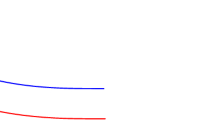Abstract
Frèchet distance is an important geometric measure that captures the distance between two curves or more generally point sets. In this paper, we consider a natural variant of Fréchet distance problem with multiple choice, provide an approximation algorithm and address its parameterized and kernelization complexity. A multiple choice problem consists of a set of color classes \(\mathcal {Q}=\{Q_1,Q_2,\ldots ,Q_n\}\), where each class \(Q_i\) consists of a pair of points \(Q_i = \{q_i, \bar{q_i}\}\). We call a subset \(A\subset \{q_i , \bar{q_i}:1\le i\le n\}\) conflict-free if A contains at most one point from each color class. The standard objective in multiple choice problem is to select a conflict-free subset that optimizes a given function. Given a line-segment \(\ell \) and a set \(\mathcal {Q}\) of a pair of points in \(\mathbb {R}^2\), our objective is to find a conflict-free subset that minimizes the Fréchet distance between \(\ell \) and the point set, where the minimum is taken over all possible conflict-free subsets. We first show that this problem is NP-hard, and provide a 3-approximation algorithm. Then we develop a simple randomized FPT algorithm for the problem when parametrized by the solution size, which is later derandomized using universal family of sets. We believe that our derandomization technique can be of independent interest, and can be used to solve other parameterized multiple choice problems. The randomized algorithm runs in \(\mathcal {O}(2^k n \log ^2 n)\) time, and the derandomized deterministic algorithm runs in \(2^k k^{\mathcal {O}(\log k)} n \log ^2 n\) time, where k, the parameter, is the number of elements in the conflict-free subset solution. Finally we present a simple branching algorithm for the problem running in \(\mathcal {O}(2^k n\log n)\) time. We also show that the problem does not have a polynomial sized kernel under standard complexity theoretic assumptions.



Similar content being viewed by others
References
Aronov, B., Har-Peled, S., Knauer, C., Wang, Y., Wenk, C.: Fréchet distance for curves, revisited. In: Proceedings of Algorithms–ESA 2006, 14th Annual European Symposium, Zurich, Switzerland, September 11–13, 2006, pp. 52–63 (2006)
Eiter, T., Mannila, H.: Computing discrete fréchet distance. Technical report, Citeseer (1994)
Hausdorff, F.: Grundzge der Mengenlehre. Veit and Company, Leipzig. Das Hauptwerk von Felix Hausdorff (1914)
Bodlaender, H.L., Downey, R.G., Fellows, M.R., Hermelin, D.: On problems without polynomial kernels. J. Comput. Syst. Sci. 75(8), 423–434 (2009)
Dell, H., van Melkebeek, D.: Satisfiability allows no nontrivial sparsification unless the polynomial-time hierarchy collapses. In: STOC, pp. 251–260 (2010)
Fortnow, L., Santhanam, R.: Infeasibility of instance compression and succinct PCPs for NP. In: STOC, pp. 133–142 (2008)
Cygan, M., Fomin, F.V., Kowalik, L., Lokshtanov, D., Marx, D., Pilipczuk, M., Pilipczuk, M., Saurabh, S.: Parameterized Algorithms. Springer, Berlin (2015)
Downey, R., Fellows, M.: Fundamentals of Parameterized Complexity. Springer, Berlin (2013)
Alt, H., Godau, M.: Computing the Fréchet distance between two polygonal curves. Int. J. Comput. Geom. Appl. 5, 75–91 (1995)
Agarwal, P.K., Avraham, R.B., Kaplan, H., Sharir, M.: Computing the discrete Fréchet distance in subquadratic time. SIAM J. Comput. 43(2), 429–449 (2014)
Shahbaz, K.: Applied similarity problems using Fréchet distance. CoRR abs/1307.6628 (2013)
Consuegra, M.E., Narasimhan, G.: Geometric avatar problems. In: IARCS Annual Conference on Foundations of Software Technology and Theoretical Computer Science, FSTTCS 2013, December 12–14, 2013, Guwahati, India, pp. 389–400 (2013)
Arkin, E.M., Banik, A., Carmi, P., Citovsky, G., Katz, M.J., Mitchell, J.S.B., Simakov, M.: Choice is hard. In: Proceedings of Algorithms and Computation—26th International Symposium, ISAAC 2015, Nagoya, Japan, December 9–11, 2015, pp. 318–328 (2015)
Arkin, E.M., Banik, A., Carmi, P., Citovsky, G., Katz, M.J., Mitchell, J.S.B., Simakov, M.: Conflict-free covering. In: Proceedings of the 27th Canadian Conference on Computational Geometry, CCCG 2015, Kingston, Ontario, Canada, August 10–12, 2015 (2015)
Agarwal, P.K., Sharir, M.: Davenport–Schinzel Sequences and Their Geometric Applications. Duke University, Durham (1995)
Atallah, M.J.: Some dynamic computational geometry problems. Comput. Math. Appl. 11(12), 1171–1181 (1985)
Hershberger, J.: Finding the upper envelope of n line segments in o (n log n) time. Inf. Process. Lett. 33(4), 169–174 (1989)
Hall, P.: On representatives of subsets. J. Lond. Math. Soc. s1–10(1), 26–30 (1935)
Edmonds, J.: How to Think About Algorithms. Cambridge University Press, New York (2008)
Naor, M., Schulman, L.J., Srinivasan, A.: Splitters and near-optimal derandomization. In: 36th Annual Symposium on Foundations of Computer Science, Milwaukee, Wisconsin, 23–25 October 1995, pp. 182–191 (1995)
Acknowledgements
The first author thanks Esther M. Arkin, Paz Carmi, Gui Citovsky, Matthew J. Katz and Joseph S. B. Mitchell for helpful discussions regarding approximation algorithms for multiple choice problems. We are grateful to Saket Saurabh for many valuable discussions and the anonymous reviewers of FSTTCS 2016 for their helpful comments. The second author is grateful for the support from Rigorous Theory of Preprocessing, ERC Advanced Investigator Grant 267959.
Author information
Authors and Affiliations
Corresponding author
Additional information
A preliminary version of the paper was presented at 36th IARCS Annual Conference on Foundations of Software Technology and Theoretical Computer Science (FSTTCS 2016).
Rights and permissions
About this article
Cite this article
Banik, A., Panolan, F., Raman, V. et al. Fréchet Distance Between a Line and Avatar Point Set. Algorithmica 80, 2616–2636 (2018). https://doi.org/10.1007/s00453-017-0352-y
Received:
Accepted:
Published:
Issue Date:
DOI: https://doi.org/10.1007/s00453-017-0352-y




